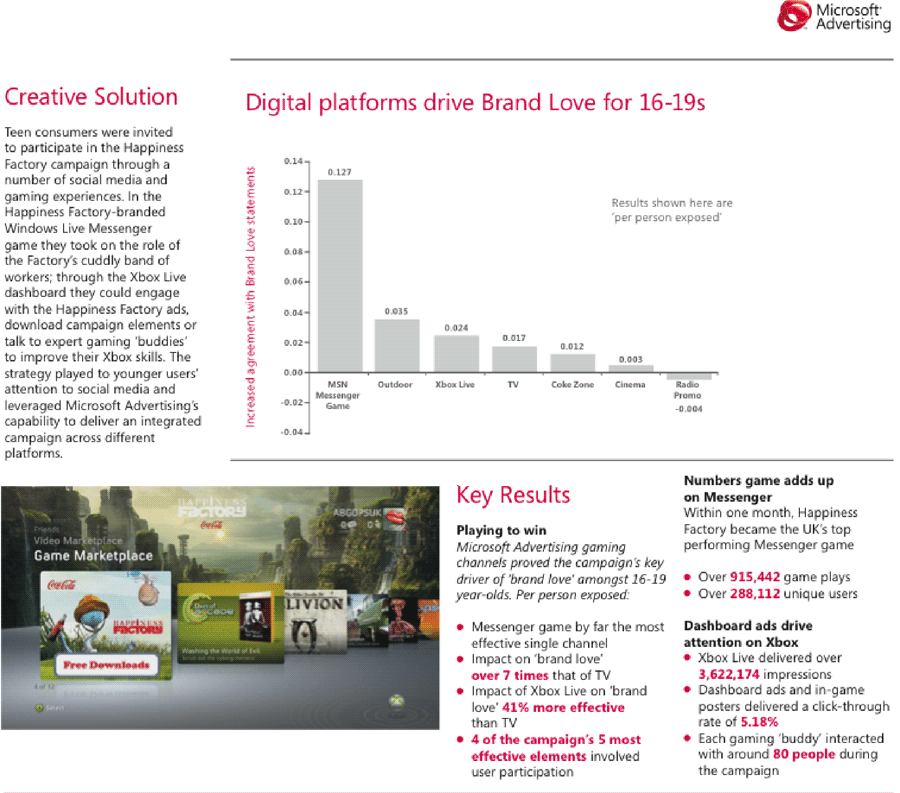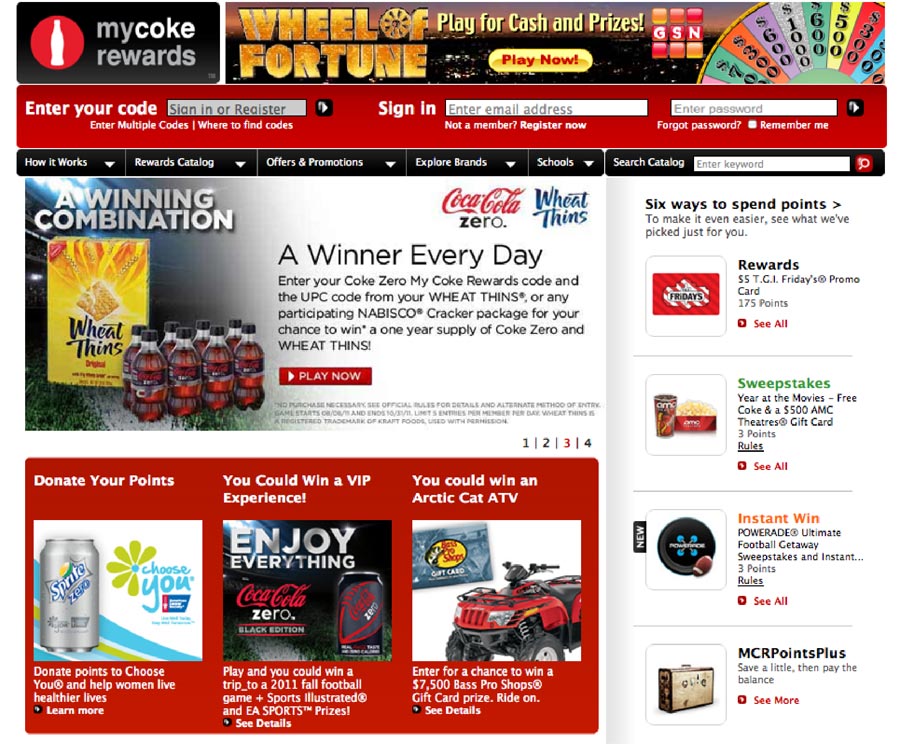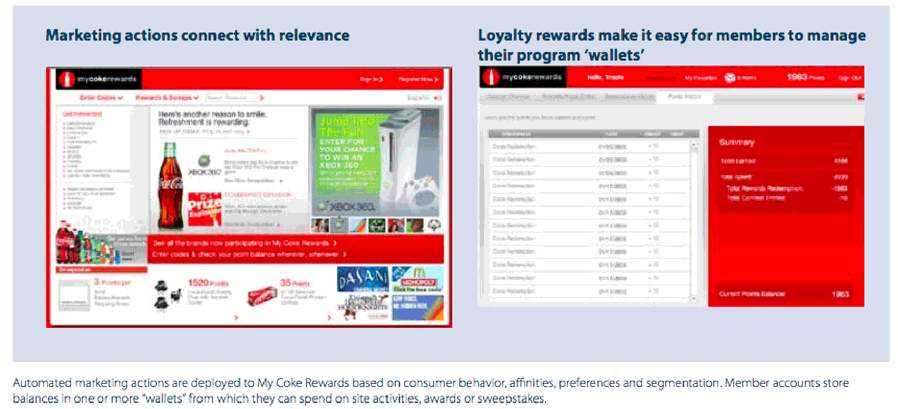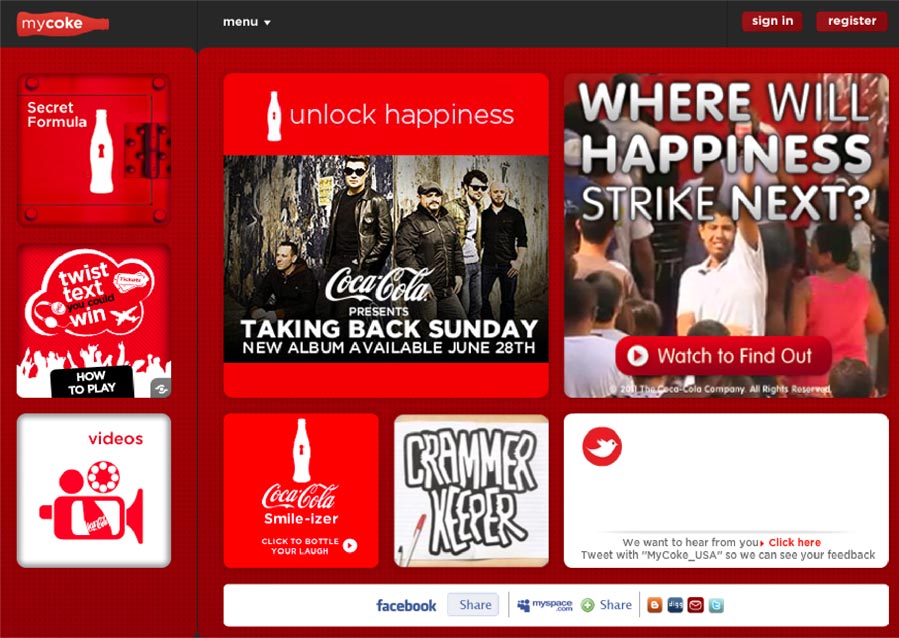Resources
Case Study: MyCoke
In 2006, Coca-Cola created its MyCokeRewards Campaign in response to flagging soda industry sales. The campaign, still active today, is a loyalty and direct-response marketing system that has offered Coke customers millions of dollars worth of prizes since its inception. To participate, consumers must create online accounts at MyCokeRewards.com, after which they can enter PIN codes printed on bottle caps and cartons to redeem rewards. Each visit captures participants’ “demographic and psychographic details,”1 giving Coca-Cola “mountains of data” they can use to “personalize the look and messaging of a particular web page, email or mobile content, or send an exclusive offer.”2 By 2009, around 285,000 users per day were entering “an average of seven codes per second” at MyCokeRewards.com.3 What’s more, the campaign speaks to Coca-Cola’s early and persistent use of behavioral targeting, the controversial practice of covertly collecting information on individuals’ online behaviors. The practice has raised privacy concerns across the globe.
“We’re especially targeting a teen or young adult audience. They’re always on their mobile phones and they spend an inordinate amount of time on the Internet. … We did some online consumer studies with Yahoo! and Nielsen that determined [that] yes, indeed, an online ad unit can make an emotional connection and encourage consumers to buy more of our products.”
Techniques:
Creating immersive environments
MyCokeRewards features dynamic and immersive digital technologies that hook users by getting them to play and engage in online activities.5 The longer they are immersed, the more they are exposed to MCR promotions and sweepstakes. For example, the Coca-Cola summer treasures promotion asks user to select a location on a Coca-Cola map, such as the Coca-Cola summer games. Users are then transported to that location online, which associates Coke with fun summer times by featuring sounds of soda fizzing, birds chirping, and people chatting. Site visitors can play games or collect rewards such as summer recipes that they can then add to a virtual “backpack” and share with friends.6
Infiltrating social networks
MyCokeRewards.com taps into users’ social networks at every turn. Users can “like” Facebook from any page on the site, follow MCR on Twitter, and email their friends to ask them to register on the MCR site. In 2009, MyCokeRewards marketers enlisted the help of “TwitterMoms,” a community active on social networks and the blogosphere to plug Coke products and connect the campaign to an education program. That same year, Coca-Cola sought to expand its social media presence through an online effort called Expedition 206, and by January 2011, had amassed more than 22 million fans on Facebook alone.7 Coca-Cola has also developed a branded YouTube channel, iPhone applications,8 and uses tools such as Radian6, Sysomos, and Scout Labs to track its brand’s online buzz.9
Location-based and mobile marketing
Mobile marketing is a big component of MyCokeRewards. Registrants at MyCokeRewards.com are asked (though not required) to provide their mobile number, which they can then use to enter codes and get news alerts, rewards info, sweepstakes opportunities, bonus points and other exclusives. Coca-Cola has also made points redeemable for wireless minutes from a number of cell phone service providers, allowing users’ phones to function similar to retailers’ plastic loyalty cards.10
Collecting personal data
The MyCokeRewards site is set up to maximize data collection, allowing marketers to establish ongoing relationships with consumers, foster engagement and build brand loyalty. Registration is available in English and Spanish to anyone 13 or older and requires users to provide their date of birth, country of residence, name, gender, street address, email address, and a password. Additionally, Coca-Cola has worked with behavioral advertising pioneer Tacoda to target individuals likely to be interested in MyCoke. The strategy helped Coke increase its consumer base and engagement with the brand.
Studying and triggering the subconscious
Coca-Cola has invested significant resources to better understand the unconscious and emotional state of its consumers, in order to advance engagement. The soft drink giant was a client of neuromarketing pioneer firm BrightHouse Neurostrategies Group,11 as well as mind and advertising research leader Olson Zaltman Associates.12 Coca-Cola has worked with companies specializing in the “understanding and measuring consumer emotional preference to deliver competitive advantage.”13,14 The company has even used biometric devices placed on the heads of consumers to decide which commercials to run.15
References:
1. Fair Isaac. The Case for Customer Centricity. Retrieved August 12, 2010 from http://www.cxo.eu.com/article/The-Case-for-Customer-Centricity/.
2. FICO.Precision Marketing Manager Product Sheet. Retrieved August 12, 2010 from http://www.fico.com/en/Products/DMApps/Pages/FICO-Precision-Marketing-Manager.aspx.
3. FICO. (2009). Boosting Sales and Site Traffic, Coca-Cola Breaks Ground in Customer Loyalty. Retrieved August 12, 2010 fromhttp://www.fico.com/en/Search/Pages/Results.aspx?k=coca%20cola. (Note: The Precision Marketing Manager also “references a database with over 1600 third party sources to match disparate and inconsistent consumer data from multiple locations to create a single data warehouse of identifiable consumers. The result is an accurate 360 view of each customer….”)
4. Quinton, B. (2008, February 1). Coke’s Kruse Control. Promo Magazine. Retrieved August 16, 2010 fromhttp://promomagazine.com/interactivemarketing/cokes_kruse_control_coca_cola_interactive_0201/index.html. (Note: Coca-Cola’s Carol Kruse did say that despite online’s measurability, “it’s very hard to track the influence of any of our marketing efforts on a purchase decision.” She also illustrated how Coca-Cola understood that in the online world, a brand had to be present simultaneously on multiple platforms,: “Take Sprite. We have the Sprite.com Web site. We have the Sprite Yard, which is a mobile program. Sprite is part of MyCokeRewards.com. And we have a Facebook page with an app, Sprite Sips. It doesn’t matter whether the experience happens on the Sprite Web site, on Facebook or on a cell phone.”)
5. MyCokeRewards. Home page. http://www.mycokerewards.com/home.do.
6. Coca Cola. Enjoy the treasures of summer. Retrieved October 11, 2011 from http://www.mycokerewards.com/showLBE.do?id=summer2&type=pillar&size=3. (Note: promotion is no longer active.)
7. McNaughton, M. (2011, February 2). How Coca-Cola Doubled its Facebook Fans in 6 Months. TWTRCON. Retrieved February 24, 2011 from http://twtrcon.com/2011/02/02/how-coca-cola-doubled-its-facebook-fans-in-6-months/.
8. Morrissey, B. (2009, February 4). Coke Dabbles in iPhone Apps. AdWeek. Retrieved October 12, 2011 fromhttp://www.adweek.com/aw/content_display/news/digital/e3i2e2fd2bc31136679bc3101796b8b9235.
9. WARC. (2010, June 1). Coca-Cola builds new social media model. Retrieved October 11, 2011 fromhttp://www.warc.com/LatestNews/News/ArchiveNews.news?ID=26773.
10. Khan, M.A. (2010, Aug. 2). How Coca-Cola’s Mobile Credit Campaign May Change Shopper Marketing. Mobile Commerce Daily. Retrieved August 16, 2010 from http://www.mobilecommercedaily.com/2010/08/02/how-coca-cola%E2%80%99s-mobile-credit-campaign-may-change-shopper-marketing.
11. The Economist. (2004, June 10). Inside the mind of the consumer. Retrieved October 18, 2011 fromhttp://www.economist.com/node/2724481.
12. Olson Zaltman Associates. Who we are: our clients. http://www.olsonzaltman.com/html/clients.html.
13. Quantitative Emotional Preference Research: The Marketing Clinic. What we deliver. http://www.qepresearch.com/what_we_deliver.php.
14. Quantitative Emotional Preference Research: The Marketing Clinic. Who we work for.http://www.qepresearch.com/who_we_work_for.php.
15. Mcclellan, S. (2008, February 18). Mind Over Matter. AdWeek. Retrieved October 18, 2011 from http://www.adweek.com/news/television/mind-over-matter-94955?pn=1.





